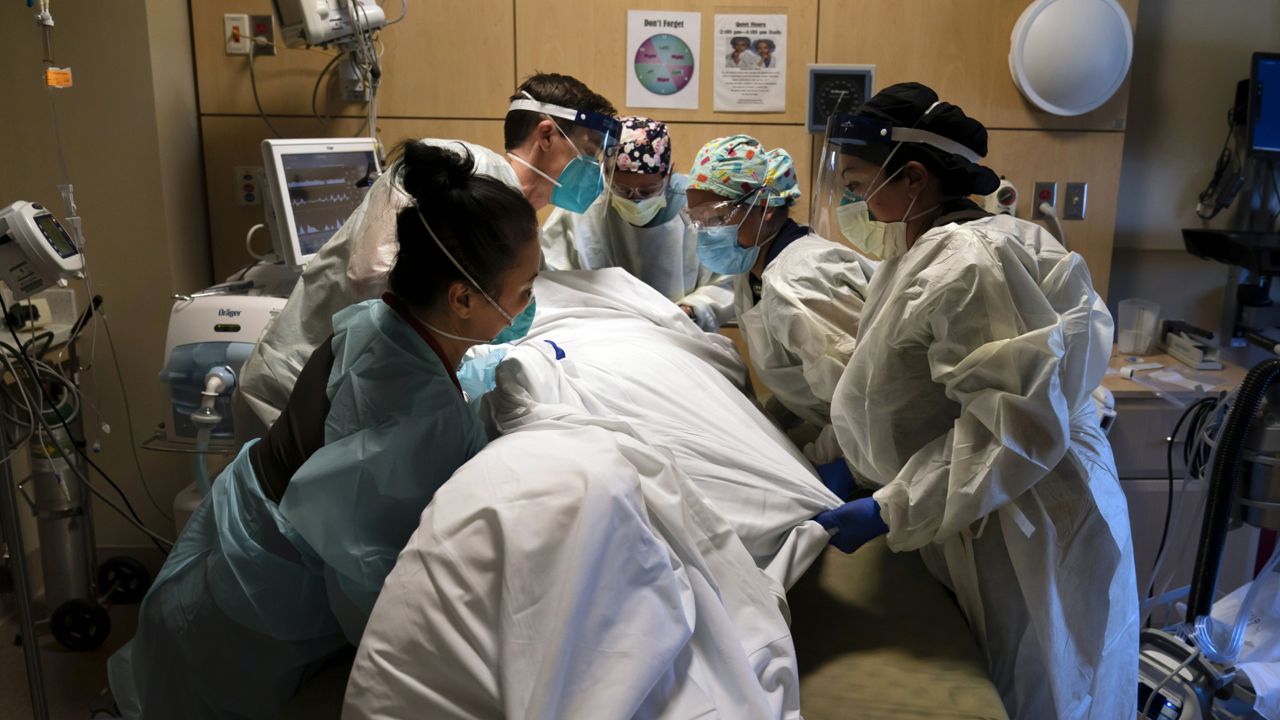LOS ANGELES (CNS) — Los Angeles County reported its highest single-day number of COVID-19-related deaths since the summer Tuesday, while hospitalization figures continued a steady upward climb that threatens the availability of intensive-care unit beds.
The county announced 86 new deaths, one of the highest daily totals reported during the entire pandemic and the highest seen since the mid-summer surge of COVID-19 cases. The new fatalities, along with seven more reported by Long Beach health officials Tuesday afternoon, lifted the overall countywide death toll to 8,438.
The county also reported 11,194 newly confirmed COVID infections, while Long Beach added 898 more, and Pasadena added 113. Long Beach officials said a backlog in the state's processing system from tests conducted last week contributed to the elevated daily case number.
The new cases lifted the countywide cumulative total from throughout the pandemic to 544,780.
Also still on the rise were hospitalization figures, with the county reporting a total of 4,403 people admitted with COVID-19, an increase of roughly 200 from Monday. According to the county Department of Public Health, roughly 21% of those patients, or about 924 people, were in ICU beds.
County officials noted that the number of people hospitalized one month ago was 1,049.
Public Health Director Barbara Ferrer estimated earlier that based on current trends, the county will have more than 5,000 people hospitalized due to the virus by the weekend.
Increasing hospitalizations have become a growing concern, particularly as they affect ICU beds.
Despite the increase in patient numbers, the county Department of Health Services on Tuesday actually reported a slight rise in available ICU beds, putting the number at 115, up from 95 on Monday. That number can fluctuate rapidly based on patient movement and available staffing. A bed is only considered "available" if there is staffing on hand to treat a patient.
Dr. Christina Ghaly, the county's health services director, said Monday there was a daily average of 2,522 overall ICU beds in the county last week — roughly equivalent to hospitals' licensed capacity — with roughly 35% of those beds occupied by COVID patients.
In terms of non-ICU hospital beds, the county DHS reported 1,046 were available as of Tuesday, also a slight increase from Monday. The county last week had a daily average total of 10,360 overall non-ICU beds, with 27% of them occupied by COVID patients.
Ghaly called the percentages of COVID patients in ICU and non-ICU beds "absolutely astonishing."
Since overall hospital space is based not on the number of physical beds, but on available staffing to treat patients, the county's total number beds can dramatically change daily.
For the past two weeks, the county — with 10 million residents — has averaged fewer than 100 available ICU beds per day, and just more than 400 standard hospital beds.
"We must all work together to prevent as many hospitalizations and deaths as possible while we wait for the COVID-19 vaccine to be widely available," Ferrer said in a statement Tuesday. "The first vaccines were administered yesterday (Monday) marking the beginning of the end of this pandemic. I ask that everyone stay strong and focus all efforts to stop the surge."
"We need to protect each other from this deadly virus by carefully abiding by the straight-forward safety measures and directives in the Health Officer Order," she said. "It worked before and it will work again when we all follow the rules."
Gov. Gavin Newsom noted Tuesday that the strain on hospital staffing across California prompted the state to temporarily lower the required staffing requirements in ICU units, from the normal one staffer for every two patients, down to one staffer for every three patients. The state also amended its quarantine requirements for health care workers exposed to COVID, lowering the mandate to just seven days, assuming the worker tests negative for the virus on day five or later of the quarantine.
Dwindling ICU capacity prompted the state to impose a regional stay at home order for the 11-county Southern California region earlier this month. The order was triggered when overall ICU capacity dropped below 15%. As of Tuesday, the state's estimated ICU capacity for the region — adjusted based on the percentage of current COVID-19 versus non-COVID-19 ICU patients — dropped to 1.7%
The state's regional stay-at-home order — which covers Los Angeles, Orange, Riverside, San Diego, Imperial, Inyo, Mono, San Bernardino, San Luis Obispo, Santa Barbara, and Ventura counties — bars gatherings of people from different households.
Under the order, the following businesses/recreational facilities were forced to close:
- indoor recreational facilities;
- hair salons and barbershops;
- personal care services;
- museums, zoos, and aquariums;
- movie theaters;
- wineries;
- bars, breweries, and distilleries;
- family entertainment centers;
- cardrooms and satellite wagering;
- limited services;
- live audience sports; and
- amusement parks.
Schools with waivers can remain open, along with "critical infrastructure" and retail stores, which will be limited to 20% of capacity. Restaurants are restricted to takeout and delivery service only. Hotels are allowed to open "for critical infrastructure support only," while churches would be restricted to outdoor only services. Entertainment production — including professional sports — would be allowed to continue without live audiences.
The order will remain in effect until at least Dec. 28.



